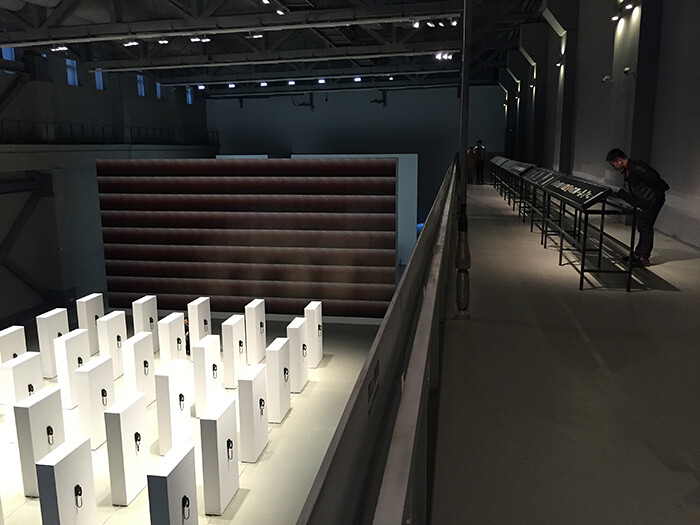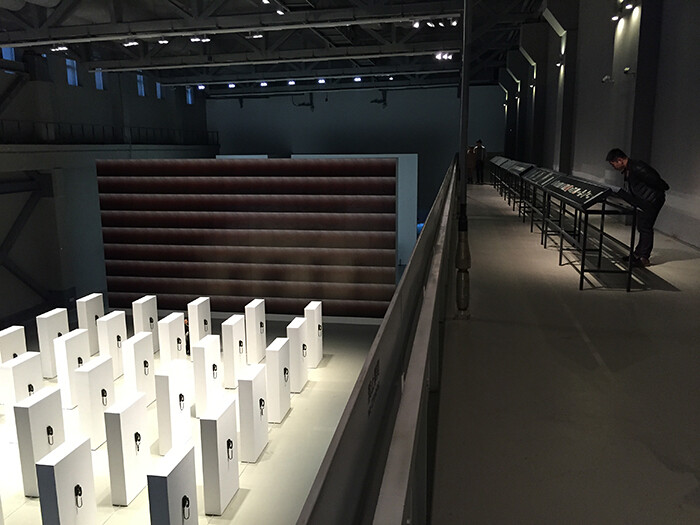The 10th Shanghai Biennale is sited inside one of Earth’s most colossal art containers, The Power Station of Art, a 42,000-square-meter decommissioned coal power plant used as the Urban Future Pavillion of the 2010 Shanghai Expo, and converted into China’s first and only state-run contemporary art institution in 2012. Entitled “Social Factory” and co-curated by a team composed of Anselm Franke, Freya Chou, Cosmin Costinas, and Liu Xiao, with Hila Peleg and Zhu Ye as curators of the film program and satellite venues respectively, the exhibition is a studied excavation of themes that are acutely felt in these halls and in Shanghai—a city which, as Franke points out in his introductory text in the catalogue, is a quintessential “image of a society-in-the-making”—and around the world, to the extent that the totalizing effects of globalized industrialization are omnipresent.
Of the many textual and historical referents put forward in the exhibition’s framing, the central one is “seek truth from facts,” a maxim that originated 2000 years ago from Ting Dynasty teachings, and which in 1938 was exhumed as a foundation of Maoism. The adage was turned on its head 40 years later, when Deng Xiaoping repurposed it in his call for the reopening and cultural reform of China.
The first work encountered in the show is THE TRUTH or: HOW TO TEACH THE PIANO CHINESE (2014), a mechanized piano and projection by Peter Ablinger and Winfried Ritsch. Though the projection was not functioning during the preview or opening day, the sound of the piano, programmed to plink a musical translation of “seek truth from facts,” reverberated throughout the behemoth three-story atrium of the museum. This sonic greeting was reminiscent of a work in Jessica Morgan’s recently opened Gwangju Biennial, which also took its locality’s past as a point of departure for a multi-faceted international exhibition. The difference in tone, however, is stark. Whereas in Gwangju it was a whimsical instrumental cover of the Talking Heads song Burning Down the House (which was also the title of the exhibition), here, the music is minimal and disjointed, with occasional flourishes of achromatic runs and crashes along the keys. Gwanjgu’s biennial feels theatrical and often macabre, while here in Shanghai, the prevailing mode is stoicism, punctuated by moments of manifest political and personal distress.
With regard to history, the pivotal moment is 1978, the aforementioned year of Deng Xiaoping’s reform, and some of the show’s fundamental works have been transposed from this point in art history. KP Brehmer’s Souls and Feelings of a Worker (Version 2) (1978–1980) are informatic works on paper charting the temperaments of various laborers as they change throughout the work day, from “very happy” to “uneasy.” Another of these formative works is Stephen Willats’s (a touchstone artist for the exhibition, with a number of other works scattered throughout the show) 1977 photographic collage series I Don’t Want to be Like Anyone Else, five different iterations of existential flowcharts with headings like “Looking at me as a human being” and “Looking at me as a reliable worker.” All the “intentions,” “conclusions,” “perceptions,” and “understandings” lead to inlaid images of melancholic wreckage: a rusting tricycle or a decomposing couch. Both works channel rather bleak abstractions of the human condition subjugated by industrial modernity. These geometrically dictated formal systems that were so popular in the 1970s—seriality, grids, other precursors and analog forms of what is now known as “digital”—abound throughout the exhibition.
A more recent work, from China, is He Xiangyu’s Everything We Create is not Ourselves 68-1 (2013–14), an ongoing, pseudo-scientific visual diary in which the artist paints a felt image of his own tongue and the space within his mouth. Evocative of Rorschach tests, the rows of expressionist blots recall the subjective, research-driven experiments of his Western forbears, inflected with the post-millennial condition of the over-share. The bridge between the “social,” referring to society and its struggles throughout the twentieth century, and the word’s association with social media today is a large part of the territory that Franke carves out in his historical and contemporary pairings.
Elsewhere in the exhibition there are works that inundate viewers with closed systems suggestive of socially impacted conditions. Ming Wong’s Windows on the World (Part 2) (2014) is a 24-channel cockpit-cum-amphitheater looking onto propagandist imagery of space exploration, from Cantonese opera on the subject to Tarkovsky’s 1972 film Solaris. The frenetic flickering of Ken Jacobs’s stereoscopic video Capitalism: Child Labor (2006) gives life to a Victorian image that captures the anguished, tedious, and exhausting condition of being a cog in a Victorian thread factory. Trevor Yeung’s installation Maracujá Road (2014) is a fastidiously plotted bamboo orchard in which the ideal structure and lighting are availed for growth, but the plants are held in permanent limbo, unable to reach their supports or to indeed thrive. Yan Jun’s installation Noise Hypnotizing (2014) consists of a field of massage tables with headphones stationed before a luxurious view of the Huangpu River and the smog that envelops it. As one approaches, the deafening screech of high-pitched white noise bleeds from the devices. One supposes that if they are worn, the body acclimates by lulling itself into a numbed state in response to the aural assault.
Liu Ding is another protagonist of the biennial. His works on view range from 1999 (2014)—a matrix of telephones, installed on room-height plinths, which loop recordings of Chinese artists discussing the arrival of international curators and the advent of Chinese contemporary art, or, alternately, their favorite songs at the time—to more recent works like For the Sake of Ten Thousand–Female Hero (2014), a triumphant female bust the artist created following the methods of 1950s social realism to a tee, principally: magnify the head to 150 percent its natural size, exaggerate facial details, and turn to a 45-degree angle. As a vision of perfection that is at once produced by the hand of an artist and the methods of an overarching cultural factory of sorts, riddled with analog “X” marks, it’s essentially data mythologized in a figurative form.
In this exhibition the figure emerges infrequently from the factory, but with meaning and emotion when it does. One of the most affecting pieces is a three-channel video projection by Zhao Liang, Black Face, White Face (2014), three landscapes of misting quarries, within each of which a nude figure lays in the frame, subsumed by the craggy elements around him. Occasionally the camera cuts in to a close-up of a man’s face blackened by coal, another powdered in limestone, or the messy hair of a third head that does not face the camera. On an entirely different register, the subjects of Firenze Lai’s portraits (Great Wall, 2014, and other paintings) are pinched and stretched into Mannerist abstractions of people, with shrunken heads and pulled torsos, who conform to the limitations of their man-made environments. Li Xiuqin’s Touch and Image—Give an Opportunity for Equality (2013) is a set of two aluminum casts of clay sculptures made by blind artists, each a rendering of the other. One is a roughly life-sized set of head and shoulders, while the other is much smaller, an almost primordial-looking orb with aberrations congealed into facial features. Their disparity is a striking representation of individual perspectives; both evince freedom from and dependence upon personal image as a dimension of agency in a world that would reduce life to resources or metrics.
The third and tightest of the biennial’s three floors constitutes a coda that simulates the production of contradictory meanings and values. This is most legible in the exhibition’s most ambitious work, Solo Show by Robbie Williams (2008–2014) initiated by Natascha Sadr Haghighian. It is a room full of sculptures made from stacked televisions, chairs, clothing, each of which, when one listens to the immersive soundtrack of horses running and jumping over hurdles, can be read as a play on one of these equestrian obstacles. Two wall texts explain the presentation as two radically different things: a solo exhibition by the fictitious artist Robbie Williams, and a collaboration among a list of nearly three-dozen names, among them Haghighian and Uwe Schwarzer, the proprietor of Mixed Media, the art fabrication company that designed and produced all the works, whose employees, along with other consultants and advisors on the project, are the other names listed on the wall.
The piece highlights two dichotomous ways of crediting artmaking: under the banner of a cohesive name, or as a product made by a vast network of individuals. These are especially self-reflexive social realities put forward among many more urgent ones that occur throughout the show. Like the exhibition as a whole, it is specific, serious (but not humorless—“not that Robbie Williams”), and committed to seeking historically conscious truth from the subjective facts artists offer the world through their work.
















